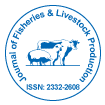Nosso grupo organiza mais de 3.000 Séries de conferências Eventos todos os anos nos EUA, Europa e outros países. Ásia com o apoio de mais 1.000 Sociedades e publica mais de 700 Acesso aberto Periódicos que contém mais de 50.000 personalidades eminentes, cientistas de renome como membros do conselho editorial.
Periódicos de acesso aberto ganhando mais leitores e citações
700 periódicos e 15 milhões de leitores Cada periódico está obtendo mais de 25.000 leitores
Indexado em
- Índice Copérnico
- Google Scholar
- Sherpa Romeu
- Abra o portão J
- Chaves Acadêmicas
- Biblioteca de Periódicos Eletrônicos
- RefSeek
- Diretório de indexação de periódicos de pesquisa (DRJI)
- Universidade Hamdard
- EBSCO AZ
- OCLC – WorldCat
- Acadêmico
- Catálogo online SWB
- Biblioteca Virtual de Biologia (vifabio)
- Publons
- Euro Pub
- Universidade de Cardife
Links Úteis
Diários de acesso aberto
Compartilhe esta página
Abstrato
Assessment of the Current Fishery Activities and Some Factors that Affect the Production of Fish in Lake Koka
Lemma Abera, Gebawo Tibesso
Lake Koka is an economically important lake in the country. However, the physico-chemical parameters of the lake seem to be threatened by anthropogenic and climatic factors, which in turn affect biotic factors as reflected in fish catch. A study was made to assess the status of fishes and factors that affect the production of the fish in the lake during 2018. Four fish species were identified. The composition of the fishes has undergone changes as compared to the last few decades. For instance, C. gariepinus, attained the highest relative frequency (35%) in this study, next to Cyprinus carpio (36%), and then followed by O. niloticus (18%) and L. intermedius (11%). The fish catch of Lake Koka currently declined from 634 tons in 2007 to 542 tons in 2018. Most of the threats resulted from the anthropogenic impacts on the lake. Increased pressure in fishing was a problem in the lake. Currently, plenty of pumps are abstracting fresh water from the lake by state and private commercial farms throughout the year that are critically affecting the water level of the lake. As a result, the lake ecosystem is being affected by catchment degradation and siltation. The study suggested that if nutrient levels continue to increase and water levels continue to decline, further changes in fish composition can be expected in the lake, especially with a shift towards fish that are mainly turbidity-tolerant species such as C. carpio. The study showed that the fishery sector has been of critical importance to the economy and to the social well-being of the fishermen in the study area. However, current harvest trends and fishery conditions put these attributes of the production at risk. It is threatened with problems of pollutions, open access to the resources, lack of technology and marketing. Hence, appropriate management is an urgent requirement that could assist in sustainable exploitation of the resources, so that the resource could contribute to food security in the study area in particular and in the country in general.
Diários por Assunto
- Agro e Aquicultura
- Alimentação e Nutrição
- Bioquímica
- Ciência da Computação
- Ciência de materiais
- Ciencias ambientais
- Ciências Clínicas
- Ciências Farmacêuticas
- Ciências gerais
- Ciências Médicas
- Ciências Sociais e Políticas
- Ciências veterinarias
- Economia e Contabilidade
- Enfermagem e cuidados de saúde
- Engenharia
- Engenheiro químico
- Física
- Genética e Biologia Molecular
- Geologia e Ciências da Terra
- Gestão de negócios
- Imunologia e Microbiologia
- Informática
- Matemática
- Química
Revistas clínicas e médicas
- Anestesiologia
- Assistência médica
- Biologia molecular
- Cardiologia
- Cirurgia
- Dermatologia
- Diabetes e Endocrinologia
- Doenças infecciosas
- Enfermagem
- Fisioterapia e Reabilitação
- Gastroenterologia
- Genética
- Hematologia
- Imunologia
- Medicamento
- Medicina Reprodutiva
- Microbiologia
- Nefrologia
- Neurologia
- Odontologia
- Oftalmologia
- Oncologia
- Ortopedia
- Pediatria
- Pesquisa Clinica
- Pneumologia
- Psiquiatria
- Toxicologia

 English
English  Spanish
Spanish  Chinese
Chinese  Russian
Russian  German
German  French
French  Japanese
Japanese  Hindi
Hindi